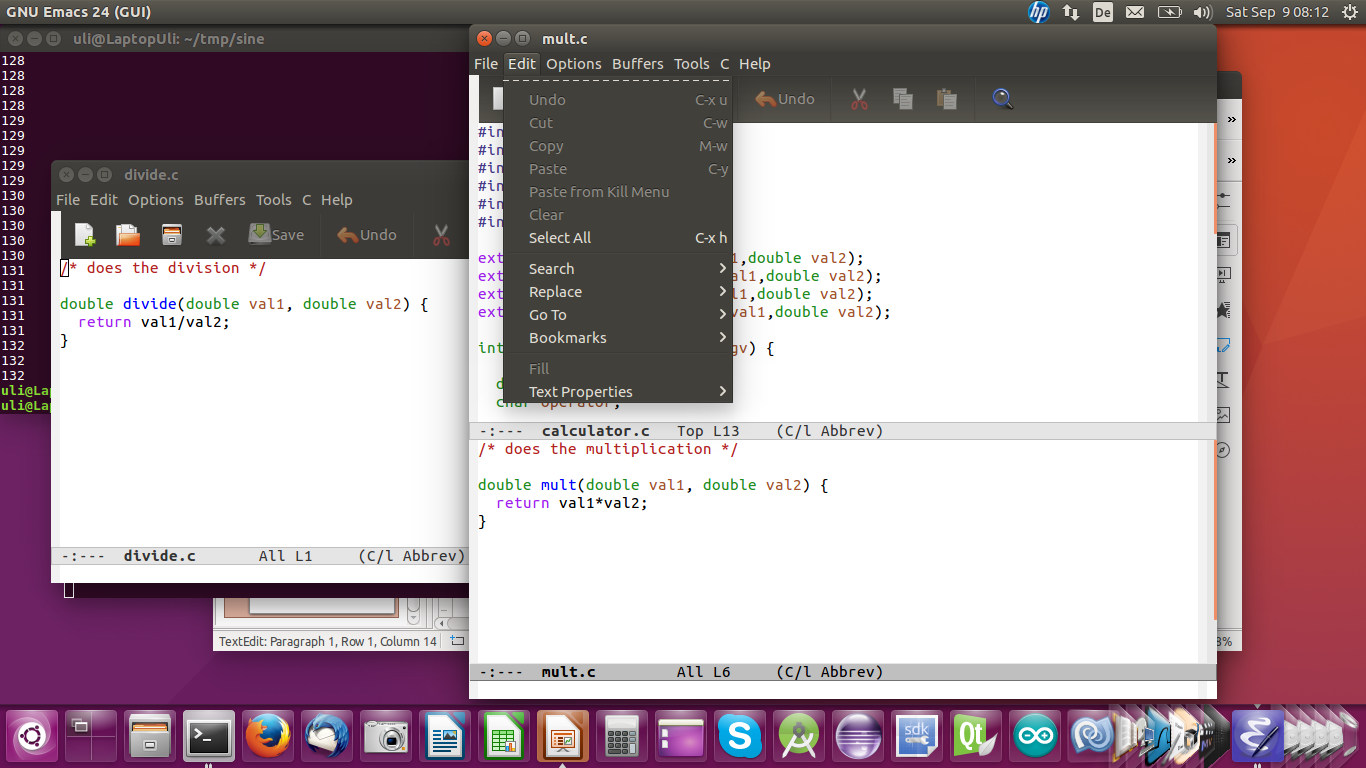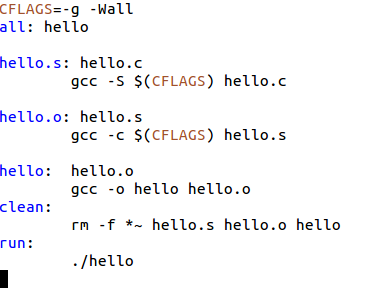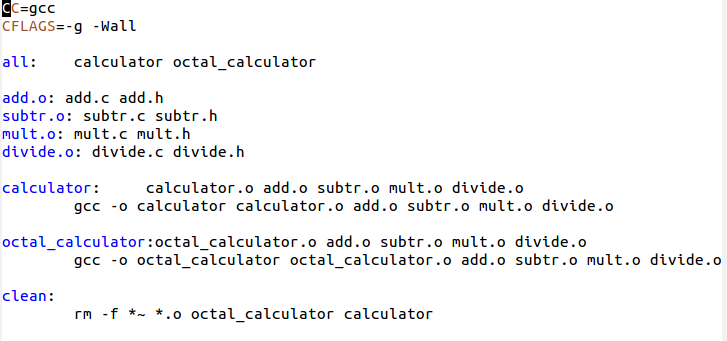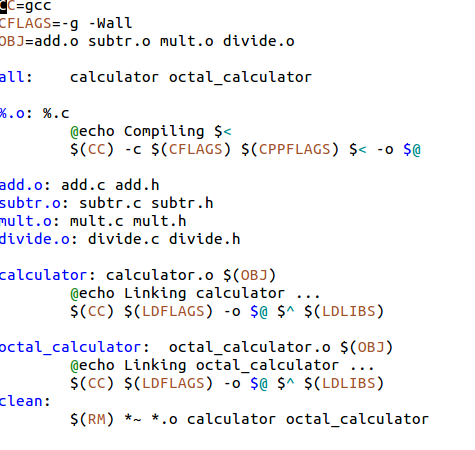
The first and most important part in the development cycle is that you think!
Of course a hello world program you can start implementing immediately.
This however is not the case for real world problems.
Break down the problem into small manageable parts that you can
implement and test individually
Think about how these smaller pieces will be interfaced with each other
to create the full program
Make a design on paper or use one of the software design tools.
There are plenty of editors on Linux:
- vi: the first and traditional full screen editor
this one is for die-hard Unix gurus but on some very small
Unix system it is the only editor installed - emacs: another traditional Unix editor
(and my favorite, probably because I know it best).
The advantage of using emacs is that the key sequences used
for editing are also understood by bash. This is also the favorite of many programmers.
People say it can do everything except making coffee.
- gedit: the editor that comes with the Gnome desktop
- joe, jed, nano, ed …
- eclipse: originally developed for Java but has “perspectives” for other languages like C, C++
- qtcreator: an IDE tailored to development of window based Qt programs. Mainly C++
- netbeans: tailored to Java but can also do C/C++
We have seen that functions can be implemented in dedicated files.
In our calculator, each operation can be implemented
in a separate function on a separate file.
We then have to compile 5 C programs to object files and
finally link these into the final executable.
The C library is automatically linked as well but we may also
need to link additional libraries (e.g. libm.so the math library).
emacs is written in lisp. It has so many functionalities
that I have no chance to show all during the lectures.
I will give a little demo but you will not be able to remember
all the key sequences even until this afternoon for the exercises
However, many functions are accessible through pull-down
menus and the key sequences are given
Emacs has an online tutorial, which you should have a look at.
!!! Interruption !!!
You want to know how to really use emacs to its full potential? Get the manual (some 635 pages!)
gcc is the de facto industry standard C compiler
It exists for many different machines
- Intel processors
- ARM MIPS
- And it comes as native or as cross compiler
gcc has several components:
- The preprocessor
this treats the #define and #include statements to
build a complete C source file for the compiler - The C compiler proper
- The assembler
- The Linker
gcc has plenty of options which may also depend on the compiler version.
gcc for ARM has different options from gcc for Intel.
Here are just a few of them:
- -Wall
don’t ignore any warnings. You may however also specify which
type of warnings you are interested in - -g keep symbol table for debugging
- -E only run the preprocessor
- -S create assembly code and stop
- -c compile into object code, don't link
Gcc input can be any of the following:
- C source code: myCode.c
- Assembly code: myCode.s
- Object code: myCode.o
- Libraries: libmylibrary.a or libmylibrary.so
We have seen that quite a few gcc commands may be needed
even if we only build a ridiculously small program as our calculator
What about a program with thousands of source files?
We need a tool with which we can describe how to build the program
and which will execute all necessary steps automatically:
make
Traditionally the description is called Makefile
(with capital M) even though any other name will do as well
The Makefile contains
- Macros (similar to Variables)
- Dependencies
- targets
The target is the thing that is to be done in this step:
hello: hello.c hello.h
In this case hello is the target and it depends on
hello.c and hello.h
Then you have the action needed to create the target
which has a tab character (invisible!) before the text:
Tab $(CC) $(CFLAGS) -o hello hello.c
This will compile and link output the hello executable
Make has predefined rules and it knows hot to produce
a .o file from a .c file
We can therefore restrict out Makefile to this:
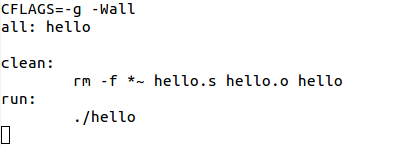

- CC is the C compiler, it defaults to cc
- CFLAGS are the flags to be passed to the C compiler
- LDFLAGS are the flags to be passed to the linker
- LDLIBS are the libraries to be linked into the executable
- RM translates into rm -f
- $< is the file that caused the action
- $* is the prefix shared by target and dependent file
- $@ is the file to be made
- $? are the dependent files that have changed
- $^ are all dependent files
You want to know more about make?
There are several tutorials on the WEB
There is also the official manual which is a
200 pages book!
To run the program we have to run ./nameOfBinary
Why do you have ./ before the program name and what does it mean?
Is there a means to run the program without the ./ ?
Beginner programmers often think that the job is done once the
program is compiled and all the syntax errors fixed.
The truth is that then the work has just justed.
Often there are programming errors (bugs) in the logic and
the program mis-behaves.
How do we spot these errors?
Very often programmers put print statements purely for the sake of debugging.
This is annoying when running the final program
where this information should not be needed any more.
One easy way out of the dilemma is given by the C preprocessor:
#define DEBUG 1
#ifdef DEBUG
p rintf(“printing some variable contents %d\n”,variable);
#endif
Commenting out the #define statement will get rid of all debugging prints.
Sometimes printing debug information is not enough
and we have to use a debugger.
gdb the GNU debugger is still the standard tool
Compile your program with the -g option to retain the symbol table
Then run the program within the debugger
gdb yourProgram
- break: set a breakpoint to stop running when arriving at this point
- run: start the program
- continue: continue running after a breakpoint
- next: execute the program line next line
- step: step into the function if the next line is a function call
- list: print the source code at the current position in the program
- bt: backtrace, show the program stack
- print: print a variable



--
Comments
| I | Attachment | History | Action | Size | Date | Who | Comment |
|---|---|---|---|---|---|---|---|
| |
complexMakefile.png | r1 | manage | 27.5 K | 2017-09-11 - 12:26 | UnknownUser | |
| |
emacs-1.png | r1 | manage | 34.1 K | 2017-09-11 - 11:27 | UnknownUser | |
| |
emacs-2.png | r1 | manage | 299.7 K | 2017-09-11 - 11:27 | UnknownUser | |
| |
helloMakefile.png | r1 | manage | 16.4 K | 2017-09-11 - 11:42 | UnknownUser | |
| |
improvedMakefile.png | r1 | manage | 38.3 K | 2017-09-11 - 11:42 | UnknownUser | |
| |
lecture_4.odp | r1 | manage | 447.3 K | 2017-10-16 - 12:40 | UnknownUser | |
| |
makeExamples.tar.gz | r1 | manage | 1.7 K | 2017-10-16 - 18:44 | UnknownUser | |
| |
simpleMakefile.png | r1 | manage | 6.6 K | 2017-09-11 - 11:48 | UnknownUser |
This topic: Embedded_Systems > WebHome > LectureSlides > Lecture4:DevelopmentTools
Topic revision: r6 - 2018-10-04 - IsaacArmahMensah
Ideas, requests, problems regarding TWiki? Send feedback




